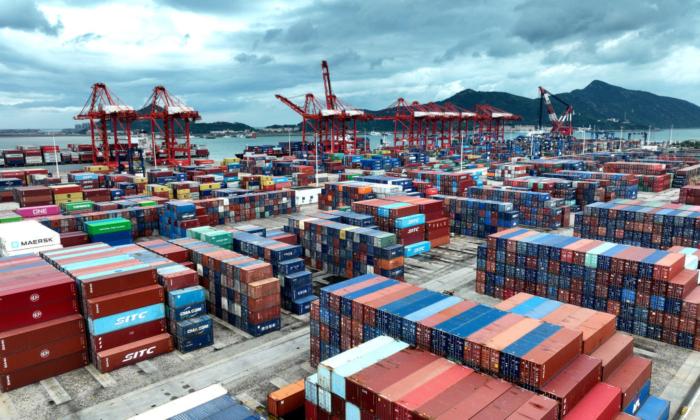The 45th president suggested that a 10 percent tariff on all goods overseas could be used to cover much of the federal debt, while protecting American producers.
Mr. Trump spoke to Mr. Kudlow about his potential economic plans if he were ever returned to the White House, as he revealed more about his “Agenda 47” election platform.
White House Attacks Former President’s Tariff Proposal
“President Biden strongly opposes plans to hurt hardworking families with higher prices and higher inflation—as even economists who served in the Trump White House warn such an agenda would,” said Deputy White House Press Secretary Andrew Bates in an Aug. 23 statement.The press secretary was likely referring to economists like Paul Winfree, a deputy director of the Domestic Policy Council under former President Trump and now president of the Economic Policy Innovation Center.
“A tariff of that scope and size would impose a massive tax on the folks who it intends to help,” Mr. Winfree told The Washington Post, adding, “It would get passed along through higher prices at a time when the Federal Reserve has had difficulty limiting inflation.”
“Combining a sweeping tariff tax on the middle class with more trickle-down tax welfare for rich special interests would stifle economic growth and fuel inflation,” Mr. Bates stated.
The former president radically shift U.S. policy toward tariffs in his first term to protect American business from unfair foreign trade practices, especially from China.
This eventually led to an escalatory trade conflict with Beijing, which retaliated with tariffs on American farmers, who were heavily reliant on massive food exports to China.
The restrictions on American food imports hit U.S. farmers particularly hard, forcing the White House to provide aid to the farmers who were affected.
However, despite earlier plans to lift some tariffs on China, the White House has kept most of those policies from the previous administration in place.
Trump Promises Higher Tariffs to Protect American Economy
The 45th president said that if he returned to office, he would work with Congress to pass what he called the “Trump Reciprocal Trade Act.”He described his universal tariff policy as creating a protective “ring around the U.S. economy.”
“Number one, I think we should have a ring around the collar, as they say,” said Mr. Trump.
“I think when companies come in and they dump their products in the United States, they should pay, automatically, let’s say a 10 percent tax … I do like the 10 percent for everybody,” he said.
He argued that the 10 percent tariff on imports would not stop business, but “would really make a lot of money.”
The former president also said he would intend on implementing a “matching tax” on certain countries on top of the universal tariff.
“We have countries that charge us 100 and 150 and 200 percent, and we charge them absolutely nothing,” he said.
“If they charge us, we charge them. Very simple.”
“Now two things will happen, one of two things: either they‘ll wipe out the tax and so will we, or we’ll take in a lot of money, and that’s OK, too. But eventually, what they’ll do is they’ll stop doing it,” he continued.
In a video released in February, the former president revealed his economic agenda for a “new pro-America system of universal baseline tariffs” on most foreign products.
“As tariffs on foreign producers go up, taxes on American producers will go down and go down very substantially. And that means a lot of jobs coming in,” Mr. Trump said in the video.
President Biden’s Economic Performance Lags in Polls
Meanwhile, the White House attempted to spin the president’s economic performance in reaction to his predecessor’s proposals and touted the decline in inflation over the past year, which slowed to 3.2 percent in July.“President Biden’s top priority is to protect the higher wages, lower costs, and progress against global inflation he’s delivering for middle-class families—which has now forced inflation lower in the United States than any wealthy peer country,” Mr. Bates said.
“That means continuing to bring jobs back to America at the strongest pace in decades—an unfulfilled promise from the last administration that this president is making a reality—and continuing to work together with our allies against trade abuses committed by countries like China.”
However, only 36 percent of Americans have a favorable opinion of President Joe Biden’s handling of the economy, according to a poll by the Associated Press-NORC Center for Public Affairs Research, last week.
Even worse, the poll also found that 55 percent of Democrats do not want to see President Biden run again in 2024, but 82 percent said they would support him if he was still the party’s nominee.
Mr. Stumo said the tariffs moved “supply chains out of our adversary China, reduced our imports of those products, and caused a 6–10 percent bump in U.S. production in those sectors.”
“Our Founding Fathers built America with high tariffs, subsidizing essential industries and building infrastructure and supply chains to overtake Europe as the most prosperous nation with the biggest middle class in history,” he added.







